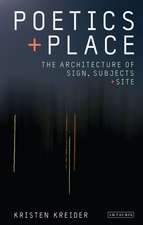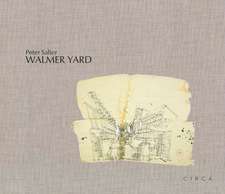Writing on the Image: Architecture, the City and the Politics of Representation
Autor Professor Mark Dorrianen Limba Engleză Hardback – 28 iul 2015
Preț: 713.41 lei
Preț vechi: 1027.66 lei
-31% Nou
Puncte Express: 1070
Preț estimativ în valută:
136.53€ • 141.82$ • 113.41£
136.53€ • 141.82$ • 113.41£
Carte tipărită la comandă
Livrare economică 01-15 februarie 25
Preluare comenzi: 021 569.72.76
Specificații
ISBN-13: 9781784530389
ISBN-10: 1784530387
Pagini: 288
Ilustrații: 45 bw integrated
Dimensiuni: 138 x 216 x 33 mm
Greutate: 0.48 kg
Editura: Bloomsbury Publishing
Colecția I.B.Tauris
Locul publicării:London, United Kingdom
ISBN-10: 1784530387
Pagini: 288
Ilustrații: 45 bw integrated
Dimensiuni: 138 x 216 x 33 mm
Greutate: 0.48 kg
Editura: Bloomsbury Publishing
Colecția I.B.Tauris
Locul publicării:London, United Kingdom
Notă biografică
Mark Dorrian is the Forbes Chair in Architecture at Edinburgh College of Art. Previously, he was at Newcastle University, where he was responsible for the creation of new research led postgraduate programmes in architecture and related disciplines. With Adrian Hawker he is co-director of the art, architecture and urbanism atelier Metis.
Cuprins
ContentsList of FiguresAcknowledgementsForeword by Paul CarterIntroduction1. The King in the City: On the Iconology of George IV in Edinburgh2. Cityscape with Ferris Wheel: Chicago 18933. Falling Upon Warsaw: The Shadow of Stalin's 'Palace of Culture'4. Adventures on the Vertical: From the New Vision to Powers of Ten5. 'The Way the World Sees London': Thoughts on a Millennial Urban Spectacle6. The Aerial Image: Transparency, Vertigo and Miniaturisation7. Clouds of Architecture8. Utopia on Ice: The Sunny Mountain Ski Dome as an Allegory of the Future9. On Google Earth10. Transcoded Indexicality11. Voice, Monstrosity and Flaying: Anish Kapoor's Marsyas as a Silent Sound Work12. Architecture and A-disciplinarity?Afterword by Ella ChmielewskaNotes on the chaptersBibliographyIndex
Recenzii
Writing on the Image is a collection of twelve beautifully written essays . [Dorrian's] work demonstrates how particular cultural artifacts drive focused criticism that needs to draw upon expansive investigation and understanding. His essays challenge orthodoxies of architectural thought, demonstrating in manifold ways the involvement of the architectural object in complex relays of broader cultural, political and technical forces.
The essays [in Writing on the Image] are beautifully written, each a rich education . Short essays such as those found in this journal are 1,500 word abstracts to a discussion perhaps not yet written, perhaps fully-formed; they merely signal a wider, more complex discourse. Mark Dorrian's Writing on the Image is that discourse. Each case study is embedded in a description of a world exposed to enormous historical and ethical and political forces.
In the world of nuclear physics Enrico Fermi was recognized by his peers as being equally gifted as an experimentalist and as a theoretician. Dorrian is that rara avis, Fermi's equivalent in the world of architecture . Reading through these scintillating essays, I often heard echoes of the dialectics and the voice of the renegade American critic Kenneth Burke.
Writing on the Image is a sort of anti-picture book where the language is at once complex, poetic and explanatory, catching at the history and reception of images.
The essays [in Writing on the Image] are beautifully written, each a rich education . Short essays such as those found in this journal are 1,500 word abstracts to a discussion perhaps not yet written, perhaps fully-formed; they merely signal a wider, more complex discourse. Mark Dorrian's Writing on the Image is that discourse. Each case study is embedded in a description of a world exposed to enormous historical and ethical and political forces.
In the world of nuclear physics Enrico Fermi was recognized by his peers as being equally gifted as an experimentalist and as a theoretician. Dorrian is that rara avis, Fermi's equivalent in the world of architecture . Reading through these scintillating essays, I often heard echoes of the dialectics and the voice of the renegade American critic Kenneth Burke.
Writing on the Image is a sort of anti-picture book where the language is at once complex, poetic and explanatory, catching at the history and reception of images.










